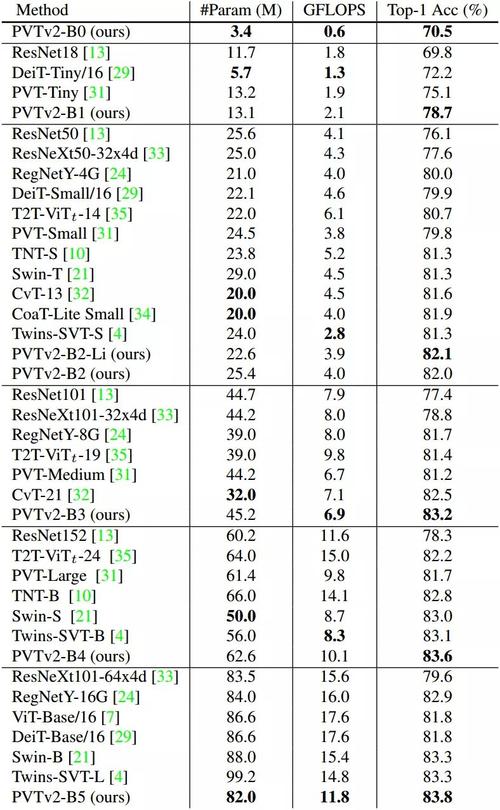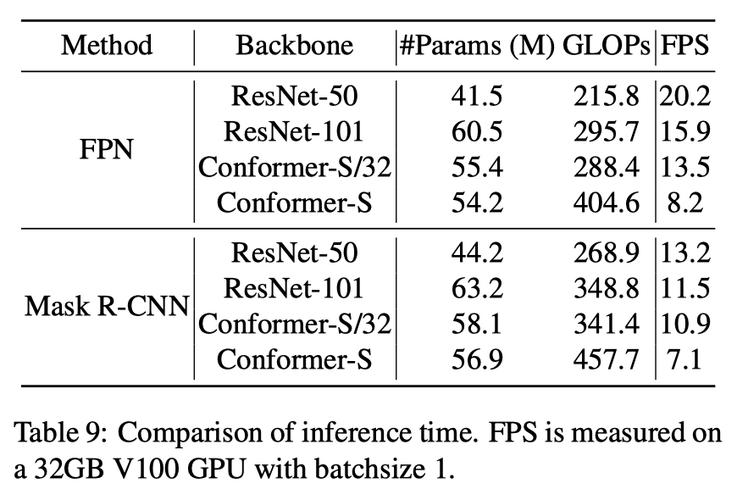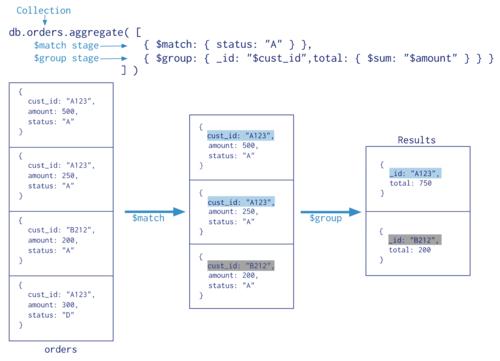近期忙于写论文,分享一下论文中表格数据的计算方法。

(图片来源网络,侵删)
一、FLOPS、FLOPs和GFLOPs的概念

(图片来源网络,侵删)
二、计算VGG16的GFLOPs和参数量
三、计算DETR的GFLOPs和参数量
四、整理数据表格
一、FLOPS、FLOPs和GFLOPs的概念
- FLOPS:注意S是大写,是 “每秒所执行的浮点运算次数”(floating-point operations per second)的缩写。它常被用来估算电脑的执行效能,尤其是在使用到大量浮点运算的科学计算领域中。正因为FLOPS字尾的那个S,代表秒,而不是复数,所以不能省略掉。
- FLOPs:注意s小写,是floating point operations的缩写(s表复数),意指浮点运算数,理解为计算量。可以用来衡量算法/模型的复杂度。
- GFLOPs:一个GFLOPs等于每秒十亿(=10^9)次的浮点运算。
二、计算VGG16的GFLOPs和参数量
from thop import profile import torch import torchvision.models as models model = models.vgg16() device = torch.device("cuda:0" if torch.cuda.is_available() else "cpu") model.to(device) input = torch.zeros((1, 3, 224, 224)).to(device) flops, params = profile(model.to(device), inputs=(input,)) print("参数量:", params) print("FLOPS:", flops)>>>output
参数量: 138357544.0
FLOPS: 15470314496.0
三、计算DETR的GFLOPs和参数量
- 首先,访问网址:Github - facebookresearch/detr: End-to-End Object Detection with Transformers
- 然后,下载DETR源码压缩包,调通源码。
- 最后,把下面的代码封装到py文件中,放到DETR源码的根目录即可。
import os import time from PIL import Image import matplotlib.pyplot as plt import torch import torchvision.transforms as T torch.set_grad_enabled(False) from models import build_model import argparse from torch.nn.functional import dropout,linear,softmax def get_args_parser(): parser = argparse.ArgumentParser('Set transformer detector', add_help=False) parser.add_argument('--lr', default=1e-4, type=float) parser.add_argument('--lr_backbone', default=1e-5, type=float) parser.add_argument('--batch_size', default=1, type=int) parser.add_argument('--weight_decay', default=1e-4, type=float) # parser.add_argument('--epochs', default=300, type=int) parser.add_argument('--epochs', default=100, type=int) parser.add_argument('--lr_drop', default=200, type=int) parser.add_argument('--clip_max_norm', default=0.1, type=float, help='gradient clipping max norm') # Model parameters parser.add_argument('--frozen_weights', type=str, default=None, help="Path to the pretrained model. If set, only the mask head will be trained") # * Backbone parser.add_argument('--backbone', default='resnet50', type=str, help="Name of the convolutional backbone to use") parser.add_argument('--dilation', action='store_true', help="If true, we replace stride with dilation in the last convolutional block (DC5)") parser.add_argument('--position_embedding', default='sine', type=str, choices=('sine', 'learned'), help="Type of positional embedding to use on top of the image features") # * Transformer parser.add_argument('--enc_layers', default=6, type=int, help="Number of encoding layers in the transformer") parser.add_argument('--dec_layers', default=6, type=int, help="Number of decoding layers in the transformer") parser.add_argument('--dim_feedforward', default=2048, type=int, help="Intermediate size of the feedforward layers in the transformer blocks") parser.add_argument('--hidden_dim', default=256, type=int, help="Size of the embeddings (dimension of the transformer)") parser.add_argument('--dropout', default=0.1, type=float, help="Dropout applied in the transformer") parser.add_argument('--nheads', default=8, type=int, help="Number of attention heads inside the transformer's attentions") parser.add_argument('--num_queries', default=40, type=int, help="Number of query slots") # 论文中对象查询为100 parser.add_argument('--pre_norm', action='store_true') # * Segmentation parser.add_argument('--masks', action='store_true', help="Train segmentation head if the flag is provided") # Loss parser.add_argument('--no_aux_loss', dest='aux_loss', action='store_false', help="Disables auxiliary decoding losses (loss at each layer)") # * Matcher parser.add_argument('--set_cost_class', default=1, type=float, help="Class coefficient in the matching cost") parser.add_argument('--set_cost_bbox', default=5, type=float, help="L1 box coefficient in the matching cost") parser.add_argument('--set_cost_giou', default=2, type=float, help="giou box coefficient in the matching cost") # * Loss coefficients parser.add_argument('--mask_loss_coef', default=1, type=float) parser.add_argument('--dice_loss_coef', default=1, type=float) parser.add_argument('--bbox_loss_coef', default=5, type=float) parser.add_argument('--giou_loss_coef', default=2, type=float) parser.add_argument('--eos_coef', default=0.1, type=float, help="Relative classification weight of the no-object class") # dataset parameters parser.add_argument('--dataset_file', default='coco') parser.add_argument('--coco_path', default='', type=str) parser.add_argument('--coco_panoptic_path', type=str) parser.add_argument('--remove_difficult', action='store_true') parser.add_argument('--output_dir', default='E:\project_yd\paper_sci_one_yd\Transformer\DETR\detr\\runs\\train', help='path where to save, empty for no saving') parser.add_argument('--device', default='cuda', help='device to use for training / testing') parser.add_argument('--seed', default=42, type=int) # ============================================================================= # parser.add_argument('--resume', default='', help='resume from checkpoint') # ============================================================================= # parser.add_argument('--start_epoch', default=0, type=int, metavar='N', help='start epoch') parser.add_argument('--eval', action='store_true') parser.add_argument('--num_workers', default=2, type=int) # distributed training parameters parser.add_argument('--world_size', default=1, type=int, help='number of distributed processes') parser.add_argument('--dist_url', default='env://', help='url used to set up distributed training') return parser if __name__ == '__main__': parser = argparse.ArgumentParser('DETR training and evaluation script', parents=[get_args_parser()]) args = parser.parse_args() # 建立模型 model, criterion, postprocessors = build_model(args) model.to('cuda:0') url = r'detr-r50-dc5-f0fb7ef5.pth' state_dict = torch.load(url) # print(state_dict) # 加载模型参数,以字典的形式表示 model.load_state_dict(state_dict['model']) model.eval() # 把字符串类型转换成字典类型 # ==================================================== # from thop import profile import torchsummary device = torch.device("cuda:0" if torch.cuda.is_available() else "cpu") model.to(device) input = torch.zeros((1, 3, 800, 1422)).to(device) flops, params = profile(model.to(device), inputs=(input,)) print("参数量:", params) print("FLOPS:", flops) # ==================================================== #>>> output
参数量: 36739785.0
FLOPS: 100937364480.0
四、整理数据表格
Model GFLOPs Params VGG16 15.47 13.84 M DETR 100.94 36.74 M >>> 如有疑问,欢迎评论区一起探讨!









